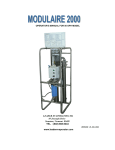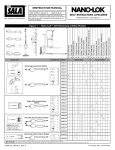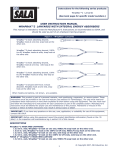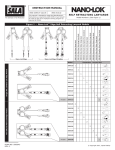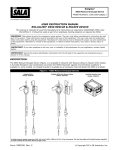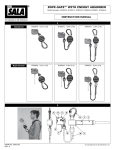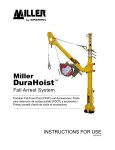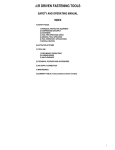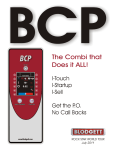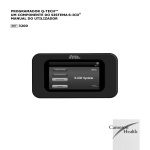Download User InstrUctIon ManUal talon™ self retractIng
Transcript
Instructions for the following series products: Talon SRLs (See back pages for specific model numbers.) User Instruction Manual Talon™ Self Retracting Lifelines This manual is intended to meet the Manufacturer’s Instructions as required by ANSI Z359.1 and should be used as part of an employee training program as required by OSHA. © Copyright 2007, DB Industries, Inc. Figure 1 - Talon Self Retracting Lifeline - 8 ft. (2.4 m) Series Locking Lever Quick Connect Attachment Handle Locking Pin ID Label Inspection and Warning Label Order Picker Attachment Handle Impact Indicator Fold i-Safe RFID Tag Self Locking Snap Hook 3 Figure 2 - Talon Self Retracting Lifeline - 16 ft. (4.9 m) Series Swivel Eye ID Label Inspection and Warning Label Impact Indicator Fold Self Locking Snap Hook 4 i-Safe RFID Tag WARNING: This product is part of a personal fall arrest system. These instructions must be provided to the user and rescuer (see section 8 Terminology). The user must read and follow the manufacturer’s instructions for each component of the system. The user must read and understand these instructions before using this product. Manufacturer’s instructions must be followed for proper use and maintenance of this product. Alteration or misuse of this product, or failure to follow instructions may result in serious injury or death. IMPORTANT: If you have questions about the use, care, or suitability of this equipment for your application contact DBI‑SALA. IMPORTANT: Before using this equipment record the product identification information from the ID label in the inspection and maintenance log in section 10.0 of this manual. DESCRIPTIONS Talon 8 ft (2.4 m) Series Self Retracting Lifeline: See Figure 1. Includes quick connect anchorage attachment handle and 8 foot (2.4 m) nylon web lifeline or order picker anchorage attachment handle and 8 foot nylon web lifeline. Talon 16 ft (4.9 m)Series Self Retracting Lifeline: See Figure 2. Includes swivel eye anchorage attachment and 16 foot (4.9 m) nylon web lifeline. 1.0 APPLICATIONS 1.1 PURPOSE: DBI‑SALA self retracting lifelines (SRL’s) are components of a personal fall arrest system (PFAS). These SRL’s may be used where worker mobility and fall protection are required. FALL PROTECTION: The SLR is used as part of a complete personal fall arrest system. Personal fall arrest systems typically include a full body harness, anchorage connector, and SRL. 1.2LIMITATIONS D.CAPACITY: The SRL is designed for use by persons with a combined weight (clothing, tools) of no more than 310 lbs. (141 kg). No more than one person may be connected to the SRL at any time. E.LOCKING SPEED: Use of the SRL in confined spaces, on slowly shifting material (sand or grain), or on a low pitched roof may not allow sufficient lock-up speed to arrest a fall. A clear fall path is required to safely arrest a fall. F.NORMAL OPERATION: Normal operation will allow the full length of the lifeline to extend and retract without hesitation or creating a slack line condition as the worker moves at normal 5 speeds. If a fall occurs, a speed sensing brake system will activate, stopping the fall and absorbing much of the energy created. If a fall has been arrested, the SRL must be removed from service and inspected. See section 5.0. Sudden or quick movements should be avoided during normal work operation as this may cause the SRL to lock-up. G.ENVIRONMENTAL HAZARDS: Use of the SRL in hazardous environments may require additional precautions to reduce the possibility of injury to the user or damage to the personal fall arrest system. Hazards may include, but are not limited to; heat, extreme cold, caustic or corrosive chemicals, high voltage power lines, explosive or toxic gases, moving machinery, sharp edges. H.TRAINING: The SRL is intended to be installed and used by persons trained in its application and use. 1.3 Refer to national standards, including the ANSI Z359 (.1, .2, .3, and .4) family of standards on fall protection, ANSI A10.32 and applicable local, state, and federal (OSHA) requirements governing occupational safety for more information about fall arrest. 2.0 SYSTEM REQUIREMENTS 2.1COMPATIBILITY OF COMPONENTS: DBI‑SALA equipment is designed for use with DBI‑SALA approved components and subsystems only. Substitutions or replacements made with nonapproved components or subsystems may jeopardize compatibility of equipment and may effect the safety and reliability of the complete system. Personal fall arrest systems must meet applicable local, state, and federal (OSHA) requirements. A full body harness must be used with the Talon SRL. 2.2COMPATIBILITY OF CONNECTORS: Connectors are considered to be compatible with connecting elements when they have been designed to work together in such a way that their sizes and shapes do not cause their gate mechanisms to inadvertently open regardless of how they become oriented. Contact DBI‑SALA if you have any questions about compatibility. Connectors (hooks, carabiners, and D-rings) must be capable of supporting at least 5,000 lbs. (22.2 kN). Connectors must be compatible with the anchorage or other system components. Do not use equipment that is not compatible. Non-compatible connectors may unintentionally disengage. See Figure 3. Connectors must be compatible in size, shape, and strength. Self locking snap hooks and carabiners are required by ANSI Z359.1 and OSHA. 2.3 MAKING CONNECTIONS: Only use self-locking snap hooks and carabiners with this equipment. Only use connectors that are suitable to each application. Ensure all connections are compatible 6 Figure 3 - Unintentional Disengagement (Roll-out) If the connecting element that a snap hook (shown) or carabiner attaches to is undersized or irregular in shape, a situation could occur where the connecting element applies a force to the gate of the snap hook or carabiner. This force may cause the gate (of either a self-locking or a non-locking snap hook) to open, allowing the snap hook or carabiner to disengage from the connecting point. Small ring or other non-compatibly shaped element 1. Force is applied to the snap hook. 2. The gate presses against the connecting ring. 3. The gate opens allowing the snap hook to slip off. in size, shape and strength. Do not use equipment that is not compatible. Ensure all connectors are fully closed and locked. DBI‑SALA connectors (snap hooks and carabiners) are designed to be used only as specified in each product’s user’s instructions. See Figure 4 for inappropriate connections. DBI‑SALA snap hooks and carabiners should not be connected: A. To a D-ring to which another connector is attached. B. In a manner that would result in a load on the gate. NOTE: Large throat opening snap hooks should not be connected to standard size D-rings or similar objects which will result in a load on the gate if the hook or D-ring twists or rotates. Large throat snap hooks are designed for use on fixed structural elements such as rebar or cross members that are not shaped in a way that can capture the gate of the hook. C. In a false engagement, where features that protrude from the snap hook or carabiner catch on the anchor and without visual confirmation seems to be fully engaged to the anchor point. D. To each other. E. Directly to webbing or rope lanyard or tie-back (unless the manufacturer’s instructions for both the lanyard and connector specifically allow such a connection). F. To any object which is shaped or dimensioned such that the snap hook or carabiner will not close and lock, or that roll-out could occur. 7 Figure 4 - Inappropriate Connections 2.4ANCHORAGE STRENGTH: In accordance with ANSI Z359.1, anchorages selected for a fall arrest systems shall have a strength capable of sustaining static loads applied in the directions permitted by the system of at least: A) 5,000 pounds (22.2 kN) for non-certified anchorages or B) Two times the maximum arresting force for certified anchorages (see section 8 Terminology). When more than one personal fall arrest system is attached to an anchorage, the strengths previously set forth in (A) and (B) shall be multiplied by the number of systems attached to the anchorage. • From OSHA 1910.66 and 1926.500: Anchorages used for attachment of a personal fall arrest system shall be independent of any anchorage being used to support or suspend platforms, and must support at least 5,000 lbs. (22.2 kN) per user attached, or be designed, installed, and used as part of a complete personal fall arrest system which maintains a safety factor of at least two, and is supervised by a qualified person. 2.5 USING THE SRL WITH A HORIZONTAL SYSTEM: The SRL and horizontal system components must be compatible. Horizontal systems must be designed and installed under the supervision of a qualified person (see section 8 Terminology). 3.0 INSTALLATION AND USE WARNING: Do not alter or intentionally misuse this equipment. Consult DBI‑SALA when using this equipment in combination with components or subsystems other than those described in this manual. Some subsystem and component combinations may interfere with the operation of this equipment. Use caution when using this equipment around moving machinery, electrical hazards, chemical hazards, and sharp edges. 8 WARNING: Consult your doctor if there is reason to doubt your fitness to safely absorb the shock from a fall arrest. Age and fitness can seriously affect your ability to withstand a fall. Pregnant women and minors must not use this equipment. 3.1 BEFORE EACH USE: Inspect the SRL according to section 5.0. 3.2 PLAN your personal fall arrest system before installing and using this equipment. Consider all factors affecting your safety during use of this equipment. A.ANCHORAGE: Select a rigid anchorage point capable of supporting at least 5,000 lbs. (22.2 kN) See section 2.4. Select an anchorage location that will avoid free fall and swing fall hazards. To prevent an increased free fall distance do not work above the anchorage. B.FREE FALL: Your personal fall arrest system must be rigged such that the SRL is above your harness attachment element (dorsal D-ring) when in use. Avoid working where your lifeline may cross or tangle with that of another worker. Figure 5 - Swing Falls Do not allow the lifeline to pass under your arms or between your feet. Never clamp, knot, or otherwise prevent the lifeline from retracting. Do not allow slack in your lifeline. Do not lengthen the SRL by connecting a lanyard or other component. C. SWING FALLS: Swing falls occur when the anchorage point is not directly above the point where a fall occurs. The force of striking an object in a swing fall may cause serious injury. In a swing fall, the total vertical fall distance will be greater than if the user had fallen directly below the anchorage point, thus increasing the total free fall distance and the area required to safely arrest the user. The SRL will NOTE: The 6 ft. minimum assumes the fall occurs from a standing position and the SRL is located overhead. If the worker is kneeling or crouching near an edge when a fall occurs, and additional 3 ft. clearance is needed. If the worker is not directly below the SRL, additional clearance is needed. 9 Chart 1 Working Distance From Anchorage 25 ft. H=Height of Talon (Overhead) 20 ft. 15 ft. 10 ft. 5 ft. 0 ft. 0 ft. 5 ft. 10 ft. 15 ft. 20 ft. D=Distance person can move (horizontally) Example: If the worker is 15 feet directly below the SRL. The recommended work zone is 12 feet in any direction activate regardless of its orientation relative to the user. The recommended work zone represents the typical acceptable work area for most applications. Review your specific application to determine what the appropriate work zone should be. See Chart 1. Minimize swing falls by working as directly below the anchorage point as possible. Never permit a swing fall if injury could occur. If a swing fall situation exists in your application contact DBI‑SALA before proceeding. See Figure 5. D.FALL CLEARANCE: Ensure adequate clearance exists in your fall path to prevent striking an object. A minimum of 6 feet from the working level to the lower level or nearest obstruction is recommended. See Figure 5. E.SHARP EDGES: Avoid working where the lifeline will be in contact with or abrade against unprotected sharp edges. Provide protection for the lifeline when possible. An energy absorbing component can sometimes be added in-line to further protect the worker. Compatibility and total fall distance must be considered if this is done. Contact DBI‑SALA before using an in-line energy absorbing component or lanyard with an SRL. F.AFTER A FALL: Equipment which has been subjected to fall arrest forces must be removed from service for inspection. See section 5. G.RESCUE: If a fall occurs, the employer must have a rescue plan and the ability to implement a rescue. 3.3 BODY SUPPORT: A full body harness must be used with the SRL. For fall arrest applications connect to the dorsal D-ring on your harness. 10 Figure 6 - Connecting to the Anchorage 3.4CONNECTING TO THE ANCHORAGE: When using a hook or carabiner to attach to the anchorage, ensure roll-out cannot occur. See section 2.3. Do not use a hook or carabiner that will not completely close over the anchorage or anchorage connector. See Figure 6. Follow the manufacturer’s instructions supplied with each system component. A. QUICK-CONNECT ATTACHMENT HANDLE: See Figure 7. To open the quick-connect attachment handle, depress the locking lever on top of the SRL. Pull the locking pin out to release the handle. Swing the handle up to open. Place the handle around the anchorage or anchorage connector. Swing the handle down and realign the holes. Push the locking pin through the holes. WARNING: Ensure the locking pin fully engages the handle and the locking lever is in the locked position. 11 Figure 7 - Using the Attachment Handles and Swivel Eye B.ORDER PICKER ATTACHMENT HANDLE: See Figure 7. Open the order picker attachment handle by removing the bolt and lock nut. Place the handle around the anchorage or anchorage connector. Reinstall the bolt and lock nut. Do not over tighten. 12 C. SWIVEL EYE: See Figure 7. Attach the SRL to the anchorage or anchorage connector by inserting a carabiner through the swivel eye and around the anchorage or anchorage connector [16 ft. (4.9 m) series only]. 3.5 ATTACHING THE Figure 8 - Attaching SRL to Harness SRL TO A FULL BODY HARNESS: For models including a quick-connect attachment handle only, and to be used with DBI‑SALA full body harnesses only. See Figure 8. To attach the SRL directly to a full body harness, pass the quick-connect attachment handle through the same loops as the existing D-ring or connector. Connect the SRL hook or carabiner to a suitable anchorage. 3.6 USING THE SRL: Connect the SRL to a suitable anchorage. Connect the SRL hook or carabiner to the appropriate connector on your full body harness. Ensure hook or carabiner is closed and locked onto the harness connector. Note: Do not use the following DBI‑SALA hooks and carabiners to connect to your full body harness: 2000108, 2007153, and 9510057. See Figure 9. Figure 9 - Hooks When connected to the SRL the worker is free to move about within the recommended working area. The lifeline should extend and retract without hesitation or creating a slack line condition as speeds. If a fall occurs the SRL will lock and arrest the fall. When disconnecting from the SRL keep the lifeline under control as it recoils back into the device. A tag line may be required to extend or retract the lifeline. 3.7 IMPACT INDICATOR: See Figure 10. The SRL incorporates an impact indicator in the lifeline. The lifeline web is folded over and stitched with red thread. The stitched fold will pull out at approximately 450 lbs. (204 kg) If the red stitching is intact the SRL has not been impacted. If the red stitching is broken and 13 the fold torn apart, the SRL has been impacted and must be removed from service and returned to an authorized service center for repair. 4.0 Figure 10 - Impact Indicator TRAINING 4.1 It is the responsibility of all users of this equipment to understand these instructions, and to be trained in the correct installation, use, and maintenance of this equipment. These individuals must be aware of the consequences of improper installation or use of this equipment. This user manual is not a substitute for a comprehensive training program. Training must be provided on a periodic basis to ensure proficiency of the users. WARNING: Training must be conducted without exposing the trainee to a fall hazard. Training must be repeated on a periodic basis. 5.0 INSPECTION 5.1 The i-Safe™ RFID tag on this SRL can be used in conjunction with the i-Safe handheld reading device and the web based portal to simplify inspection and inventory control and provide records for your fall protection equipment (see Fig. 11). Figure 11 - RFID Tag 5.2 FREQUENCY: • Before Each Use: i-Safe RFID Tag OSHA 1910.66, OSHA 1926.502 and ANSI Z359.1 requires an inspection of equipment before each use. See sections 5.2, 5.3, and 5.4 for inspection guidelines. • Annually: ANSI Z359.1 requires a formal inspection of the SRL be completed by a competent person other than the user. More frequent inspections by a competent person may be required based on the nature and severity of workplace conditions affecting the equipment and the modes of use and 14 exposure time of the equipment. See sections, 5.3, and 5.4 for inspection guidelines. Record results in the inspection and maintenance log in section 10.0, or use the i-Safe™ inspection web portal to maintain your inspection records. If you are a first-time user, contact a Customer Service representative in the US at 800-328‑6146 or in Canada at 800‑387‑7484 or if you have already registered, go to: www.capitalsafety. com/isafe.html. Follow instructions provided with your i-Safe handheld reader or on the web portal to transfer your data to your web log. *NOTE: In Canada, CSA requires SRLs to be serviced within two years of the manufactured date, and annually thereafter. • After a Fall Arrest: Inspect impact indicator according to section 5.3, and the entire SRL according to sections 5.4 and 5.5. 5.3 IMPACT INDICATOR: To inspect the impact indicator, find the fold in the lifeline stitched with red thread, as shown in Figure 10. If the red stitching is broken and the fold torn apart, the SRL has been impacted and must be removed from service and returned to an authorized service center for repair. Do not re-stitch the fold. WARNING: If the SRL has been subjected to fall arrest or impact forces it must be removed from service and returned to an authorized service center for repair. 5.4 INSPECTION STEPS: Step 1. Check for loose screws and bent or damaged parts. Step 2. Check the housing for distortion, cracks, or other damage. Ensure the anchorage point is not damaged or distorted. Step 3. The lifeline must fully extend and retract smoothly with no hesitation or slack line condition. Step 4. Ensure the device locks when the lifeline is pulled sharply. Lock‑up should be positive, with no slipping. Step 5. All labels must be present and fully legible. Step 6. Check for corrosion on the entire unit. Step 7. Check the lifeline for cuts, burns, chemical damage, or severely abraded areas. The lifeline must not be damaged. Step 8. Check the connecting hooks or carabiners for damage, distortion, or corrosion, and working condition. Step 9. Inspect each component of the personal fall arrest system according to manufacturer’s instructions. 15 Step 10.Record the inspection results in the inspection and maintenance log in section 10.0 or using the I-safe web portal. 5.5 If the inspection reveals an unsafe or defective condition, remove the SRL from service and contact an authorized service center for repair. NOTE: Only DBI‑SALA or parties authorized in writing may make repairs to this equipment. 6.0 MAINTENANCE, SERVICING, AND STORAGE 6.1 MAINTENANCE: A. HOUSING: Periodically clean the exterior of the SRL with water and a mild detergent. Position the SRL so water can drain out. Clean the labels as required. B.LIFELINE: Clean the lifeline with water and a mild detergent. Rinse and thoroughly air dry. Do not force dry with heat. An excessive build-up of dirt or other contaminants may prevent the lifeline from fully retracting, causing a potential free fall hazard. Return the SRL to an authorized service center for lifeline replacement if necessary. C. PERSONAL FALL ARREST SYSTEM COMPONENTS: Clean and store associated system components according to manufacturer’s instructions. 6.2SERVICING: Do not disassemble the SRL. Do not lubricate any part of the SRL. Additional maintenance and servicing must be performed by an authorized service center. A return authorization number must be issued by DBI‑SALA. See section 5.2 for servicing frequency. 6.3STORAGE: Store the SRL in a cool, dry, and clean environment, out of direct sunlight. Avoid storing the SRL in areas where chemical vapors exist. Thoroughly inspect the SRL after extended storage. 7.0 SPECIFICATIONS 7.1 PERFORMANCE SPECIFICATIONS: • Capacity (All Models): 75 - 310 lbs. (34 - 141 kg), one user only • Working Range, 8 Foot Models: 2.5 ft. - 8 ft (.8 m - 2.4 m) • Working Range, 16 Foot Models: 1.5 ft. - 16 ft (.5 m - 4.9 m) • Maximum Arresting Force (All Models): 900 lbs. (408 kg) when tested in accordance with ANSI Z359.1. • Average Locking Speed (All Models): 4.5 ft./sec. (1.4 m / sec.) • Maximum Arresting Distance (All Models): 42 in. (1 m) 16 7.2 PHYSICAL SPECIFICATIONS: 8 Foot Models: • Overall Dimensions, Quick-Connect Attachment Handle Models (LxWxH): 6.7 x 3.9 x 2.2 in. (17 cm x 10 cm x 6 cm) • Overall Dimensions, Order Picker Attachment Handle Models (LxWxH): 8.9 x 3.9 x 2.2 in. (23 cm x 10 cm x 6 cm) 16 Foot Models: Overall Dimensions (LxWxH): 7.9 x 5.9 x 2.4 in. (20 cm x 15 cm x 6 cm) ALL MODELS: Materials: Housing: Nylon Cable Drum: Glass filled nylon Internal Components: Steel/Aluminum Lifeline: 3/4 inch nylon web 7.3 PATENTS AND REQUIREMENTS: 8.0 • • Patents Pending Meets ANSI Z359.1 and OSHA requirements Terminology Authorized Person: A person assigned by the employer to perform duties at a location where the person will be exposed to a fall hazard (otherwise referred to as “user” for the purpose of these instructions). Rescuer: Person or persons other than the rescue subject acting to perform an assisted rescue by operation of a rescue system. Certified Anchorage: An anchorage for fall arrest, positioning, restraint, or rescue systems that a qualified person certifies to be capable of supporting the potential fall forces that could be encountered during a fall or that meet the criteria for a certified anchorage prescribed in this standard. Qualified Person: A person with a recognized degree or professional certificate and with extensive knowledge, training, and experience in the fall protection and rescue field who is capable of designing, analyzing, evaluating and specifying fall protection and rescue systems to the extent required by this standard. Competent Person: One who is capable of identifying existing and predictable hazards in the surroundings or working conditions which are unsanitary, hazardous, or dangerous to employees, and who has authorization to take prompt corrective measures to eliminate them. 17 9.0 LABELING 9.1 The following labels must be present and fully legible: 8 Foot Series SRL: ANSI ID Label ANSI Warning/Inspection Label CSA ID Label CSA Warning/Inspection Label 18 16 Foot Series SRL: ANSI ID Label ANSI Warning/Inspection Label CSA ID Label CSA Warning/Inspection Label i-Safe RFID Label 19 10.0 INSPECTION AND MAINTENANCE LOG SERIAL NUMBER: MODEL NUMBER: DATE PURCHASEd: INSPECTION DATE INSPECTION ITEMS NOTED CORRECTIVE ACTION Approved By: Approved By: Approved By: Approved By: Approved By: Approved By: Approved By: Approved By: Approved By: Approved By: Approved By: Approved By: Approved By: Approved By: 20 MAINTENANCE PERFORMED 10.0 RELEVÉ D’INSPECTION ET D’ENTRETIEN NUMÉRO DE SÉRIE: NUMÉRO DE MODÈL: DATE D’ACHAT: DATE D’INSPECTION OBSERVATIONS MESURE CORRECTIVE Approuvé par : Approuvé par : Approuvé par : Approuvé par : Approuvé par : Approuvé par : Approuvé par : Approuvé par : Approuvé par : Approuvé par : Approuvé par : Approuvé par : Approuvé par : Approuvé par : 21 ENTRETIEN EFFECTUÉ 10.0 HOJA DE REGISTRO DE INSPECCIONES Y MANTENIMIENTOS FECHA DE FABRICACIÓN: NÚMERO DE MODELO: FECHA DE ADQUISICIÓN FECHA DE INSPECCIÓN OBSERVACIONES MEDIDAS CORRECTIVAS Aprobada por: Aprobada por: Aprobada por: Aprobada por: Aprobada por: Aprobada por: Aprobada por: Aprobada por: Aprobada por: Aprobada por: Aprobada por: Aprobada por: Aprobada por: Aprobada por: 22 MANTENIMIENTO REALIZADO This instruction applies to the following models: 3101000 3101001 3101002 3101003 3101004 3101005 3101006 3101007 3101008 3101009 3101010 3101011 3101012 3101013 3101014 3101015 3101016 3101017 3101018 3101019 3101021 3101050 3101051 3101052 3101053 3101054 3101055 Additional model numbers may appear on the next printing. WARRANTY Self Retracting Lifelines offered by DBI‑SALA are warranted against factory defects in workmanship and materials for a period of two years from date of purchase. Upon notice in writing, DBI‑SALA will promptly repair or replace all defective items. DBI‑SALA reserves the right to have any defective item returned to it’s plant for inspection before making a repair or replacement. Warranty does not cover equipment damages resulting from abuse, damage in transit, or other damage beyond the control of DBI‑SALA. This warranty applies only to the original purchaser and is the only one applicable to our products, and is in lieu of all other warranties, expressed or implied. GARANTIE Les cordes d’assurance auto-rétractables offertes par DBI‑SALA sont garanties contre tout défaut de l’usine en matière de main-d’œuvre et de matériaux pendant une période de deux ans à compter de la date d’achat. Sur réception d’une note écrite, DBI‑SALA s’engage à réparer ou remplacer rapidement les articles défectueux. DBI‑SALA réserve le droit de faire inspecter à son usine tout item défectueux qui lui a été retourné avant de le réparer ou de le remplacer. La garantie ne couvre pas les dommages à l’équipement au-delà du contrôle de DBI‑SALA. Cette garantie s’applique seulement à l’acheteur original et est la seule applicable à nos produits et remplace toute autre garantie, explicite ou implicite. GARANTÍA Las cuerdas de salvamento autorretráctiles ofrecidas por DBI‑SALA están garantizadas por cualquier defecto de fábrica, en cuanto a mano de obra y materiales, durante un período de dos años desde la fecha de compra. Previo aviso por escrito, DBI‑SALA reparará o reemplazará de inmediato cualquier pieza defectuosa. DBI‑SALA se reserva el derecho de decidir si se devuelve a la planta cualquier elemento defectuoso para su inspección, antes de llevar a cabo su reparación o sustitución. Esta garantía no cubre los daños al equipo ocasionados por el abuso, daño en tránsito u otros daños ajenos al control de DBI‑SALA. Esta garantía sólo se aplica al comprador original y, únicamente, a nuestros productos, en sustitución de todas las demás garantías expresas o implícitas. USACanada 3833 SALA Way Red Wing, MN 55066-5005 Toll Free: 800-328-6146 Phone: (651) 388-8282 Fax: (651) 388-5065 Email: [email protected] www.capitalsafety.com 260 Export Boulevard Mississauga, Ontario L5S 1Y9 Toll Free: 800-387-7484 Phone: (905) 795-9333 Fax: (905) 795-8777 Email: [email protected] www.capitalsafety.com This instruction manual is available for download at www.capitalsafety.com. Vous pouvez télécharger ce manuel à l’adresse suivante: www.capitalsafety.com Este manual de instrucciones está disponible para ser descargado en www.capitalsafety.com. I S O 9001 Certificate No. FM 39709 Form: 5911858 Rev: H
























